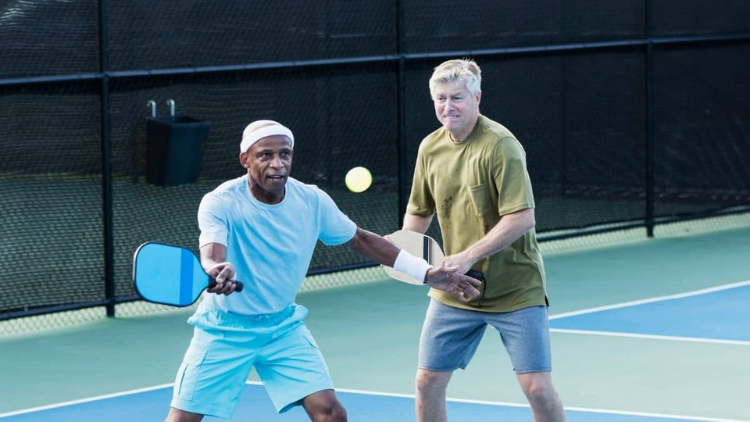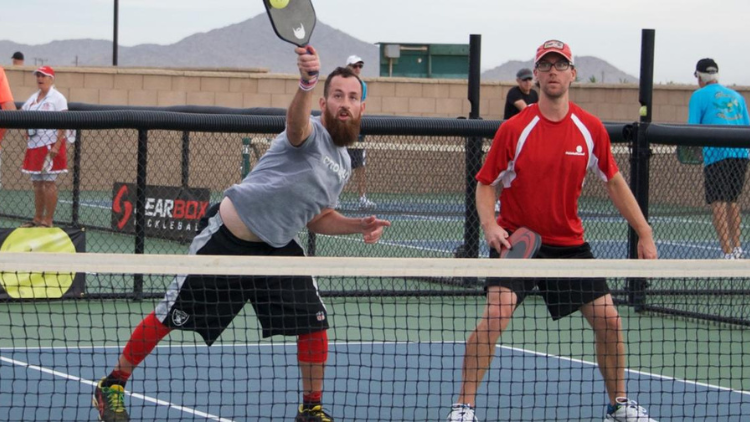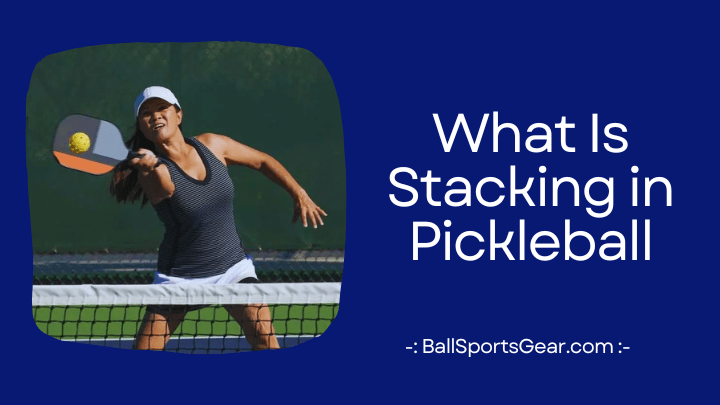Are you new to the world of Pickleball and curious about the term “stacking”? Or maybe you’ve been playing for a while but still unsure what it means? Well, look no further! In this post, we’ll dive into all things stacking – from what it is, why players do it, and how to effectively utilize this strategy in your game. So grab your paddle and let’s get started.
Concept Of Stacking In Pickleball
Players use their paddles to strike the ball back and forth across the net in pickleball, a real-time paddleball game played with little round balls. The goal of the game is to score points by striking the ball into the court of your opponent or into one of the nets that are placed at either end of the playing field.
Pickleball can be played in a few different ways, but one of the most well-liked variations is called “stacking.” When stacking, you hit the ball up towards the ceiling or another high point in your opponent’s half of the court rather than towards your opponent’s court. You swiftly hit the ball past them and into their half of the court as your opponent tries to return it to your side of the court. They face an unexpected difficulty as a result of having to change their approach with each shot.
Stacking is an excellent method to make your matches unpredictable while also keeping things exciting for you as you strive to deceive your opponent. As you get better at this hard form of pickleball, it’s also a terrific method to increase speed and accuracy.
Tips for Playing Better Pickleball
Playing better pickleball is all about having a good plan and sticking to it.Here are some tips for playing better pickleball:
- Observe the ball at all times. Maintain constant focus on the ball while you are playing. You can make wise selections about where to hit the ball by keeping track of what’s happening on the court.
- Place your stacks correctly. It’s crucial to use the right stack positions when playing pickleball so that you can effectively hit your opponent’s balls and protect your own. To block any shots that are thrown your way, for instance, when you’re in the backcourt, try to remain close to the front court.
- Make good volleys. Volleys are one of the most important skills in pickleball – they enable you to move up the court and score points against your opponents. To make a good volley, aim well and use your body weight to power the shot home.
- Be patient. One of the keys to playing better pickleball is being patient – don’t try to do too many things at once, and don’t get frustrated if things don’t go as planned initially. Rather than trying to force things, take things step by step and work towards a goal this will help you play more efficiently and effectively overall.
When To Use Or Avoid Stacking In a Game
Playing two or more cards of the same rank one after the other is referred to as stacking. Often, players employ stacking to their advantage when they seek to outwit their rival. Personal preference will determine when to stack in a game, however some players think stacking is always favourable. Others think that stacking should only be used when it clearly benefits the player. In order to decide whether or not stacking is suitable in a certain situation, it is crucial to take the context into account.

When To Use Or Avoid Stacking In a Game
When to use or avoid stacking in a game of Pickleball is a question that can be difficult to answer. There are times when stacking can be helpful, and other times when it can be detrimental. When stacking is beneficial, it can help you cover more ground on the court and keep your opponent from hitting balls into your side of the court.
When stacking is detrimental, it often leads to an accident because players are trying to reach for the same ball at the same time. It’s important to pay attention to your opponent and stack only when necessary. There are also situations where players may want to avoid stacking altogether. For instance, if one player is able to hit several long shots while another player is trying to block them, the second player may want to avoid stacking in order to give himself more time to react.
Advantages and disadvantages of Stacking
Stacking is an ensemble machine learning technique that combines multiple models to improve the predictive performance. Here are some advantages and disadvantages of stacking.
Advantages
- Improved predictive performance stacking can improve the predictive performance by combining the strengths of multiple models.
- Solves difficult problems Complex problems that are challenging to answer with a single model can be handled through stacking.
- Flexibility stacking is adaptable and compatible with various models and data sets.
- Stacking, which combines the predictions of various models, can lessen the danger of overfitting.
Disadvantages
- As it entails training many models and integrating their outputs, computational cost stacking can be costly.
- Data requirements Stacking needs a lot of data to train several models, which might not be possible in some circumstances.
- Model selection selecting the best models to include in the stack can be a challenge, and may require significant experimentation.
- Since it combines the predictions of different models, interpretability stacking can be challenging to understand. This can make it challenging to comprehend how the outcome was predicted.
Common mistakes when using the stacking strategy
In many different fields, including sports like pickleball, stacking is a machine learning technique that can be applied. Here are some common mistakes to avoid when using the stacking strategy in pickleball.
- Different skill levels among pickleball players can have an impact on a player’s performance. The skill level of each player should be taken into account while developing a stacking model and should be a feature.
- Overfitting to specific tournaments pickleball tournaments can vary in terms of the players who participate, the venue, and the conditions. It’s important to avoid overfitting to specific tournaments by using a diverse set of tournaments for training and testing.
- Despite its significance in pickleball, shot selection is a crucial aspect of the game. It’s crucial to take into account the kinds of shots that players take and how they impact the result of the game while developing a stacking model.
- In pickleball, players are matched into teams without using pairing information, and each team’s performance may depend on player compatibility. When developing a stacking model, it’s important to consider player pairings and provide that information as a function.
- Not tuning hyperparameters can have a substantial impact on stacking model performance. To achieve the greatest performance, the hyperparameters of the base models and the meta-model must be optimised.
- Neglecting to evaluate performance on a separate test set: It’s important to evaluate the performance of the stacking model on a separate test set to avoid overfitting and ensure that the model generalizes well to new data.

Tips For Effective Communication While Stacking
When stacking in pickleball, it is important to keep your communication clear and concise. Here are some tips for effective stacking:
- Establish a stack order early in the game. This will help you coordinate your shots and make sure everyone is on the same page.
- Use hand signals hand signals are a great way to communicate with your partner without having to yell across the court. Decide on a set of hand signals beforehand, such as pointing to the left or right, signaling for a lob or a drop shot, etc.
- Instead of waiting for your partner to initiate communication, take the initiative yourself. Tell your partner what you are contemplating and what you plan to do next.
- Avoid criticizing your partner during gameplay. Instead, offer constructive feedback and positive reinforcement. Remember, you are a team and working together to achieve a common goal.
- The key to good communication is a positive attitude and enthusiasm. Even if you make mistakes, stay positive and support your partner.
- Effective communication takes practice. Spend time on the court practicing your communication skills with your partner, and don’t be afraid to make adjustments if something isn’t working.
Frequently Asked Questions
Yes, stacking is legal in tournament play in pickleball. The official rules of the game do not prohibit stacking, which involves having the stronger player in a doubles partnership play on the side of the court where they can hit more shots. However, some tournaments may have their own rules or guidelines regarding stacking.
Here are some strategies to counteract a team that is utilizing stacking in pickleball:
1) Employ more lob shots to force the stronger player to move back,
2) Change the pace and angle of your shots to disrupt the stacking strategy,
3) Vary the serving and returning positions to make it harder for the team to stack,
4) Practice and improve your own stacking strategy.
Certainly, adopting the stacking approach in pickleball games has some drawbacks. It can make it easier for opponents to forecast shot placements, leaving the court open to specific shots, and lead to the opposing team targeting a weaker player.
Stacking in pickleball can offer several benefits, including allowing the stronger player to cover more ground and hit more shots, creating more offensive opportunities, and potentially intimidating opponents. It can also help improve communication and strategy between doubles partners.
Conclusions
stacking in pickleball is a strategy where the stronger player in a doubles partnership plays on the side of the court where they can hit more shots. It can provide several advantages, such as improved offensive opportunities and communication between partners. However, it also has some disadvantages, such as making it easier for opponents to predict shot placements. To be successful in pickleball, players should practice effective communication and employ strategies to counteract their opponents’ stacking technique.

